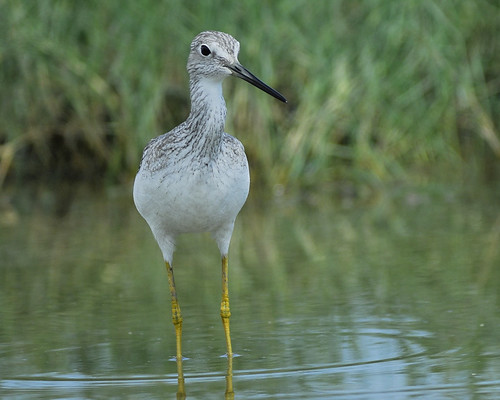tags: Greater Yellowlegs, Tringa melanoleuca, birds, nature, Image of the Day
[Mystery bird] Greater Yellowlegs, Tringa melanoleuca, photographed at Smith Point, Texas. [I will identify this bird for you tomorrow]
Image: Joseph Kennedy, 7 September 2008 [larger view]. [voice: mp3: Gough, G.A., Sauer, J.R., Iliff, M. Patuxent Bird Identification Infocenter. 1998. Version 97.1. Patuxent Wildlife Research Center, Laurel, MD].
Nikon D200, Kowa 883 telescope TSN-PZ camera eyepiece 1/750s f/8.0 at 1000.0mm iso400.
Read and learn from a detailed ID diagnosis below ..
Rick Wright, Managing Director of WINGS Birding Tours Worldwide, writes:
Well, a shorebird with yellow legs. Could it be? Indeed it is. The overall gray plumage, "intelligent" face with large eye, and long legs make this unmistakably a yellowlegs. The other tallish yellow-legged sandpipers are quite different in shape and structure: Stilt Sandpiper is short-necked and large-headed with a drooping bill, Wilson's Phalarope pudgy and ridiculously small-headed.
Most shorebirders will have gone straight, so to speak, to the bill of the quiz bird, which is, in this view at least, straight, pale-based, and clearly longer than the head is wide. This is indeed a Greater Yellowlegs, as those well-known bill characters suggest.
But indulge me in an experiment. Cover up the head and bill of this bird on your screen--and most even somewhat experienced birders will still get it right! How come? There's nothing in the photo for scale, so we can't see the superior size of Greater Yellowlegs. But we can see something just as helpful. Note that this bird has a clear "Adam's apple" lump in its throat, and that the thigh muscles bulge out from the flank; the breast is broad and substantial. The Shorebird Guide -- the only book a birder really needs -- describes the body of Greater Yellowlegs as "sculpted," unlike the wimpy elegance of a Lesser. Bird identification is all about developing a mental library of such images, and constructing a lexicon to describe them.
- Log in to post comments


Lesser yellowlegs, though it's hard to use the bill:head ratio from this angle :)
We called these Killdees I think. (I grew up on the south Texas coast.) It's been a while.
Hi, I am a guide dog raiser in Seattle, WA. The puppy I am currently raising is named Shep. I love your blog and I love reading about other people's pet experiences. I also have a website where I sell pet supplies and i have a blog on it also about guide dogs. I built the site to try and help raise money for guide dogs and other animal charities. And if anyone would be willing to write a blog post on my blog or website or about the work i do with guide dogs, it would be very much appreciated and i could do the same in return.
Greater Yellowlegs. The bill is long, slightly upcurved, and pale at the base.
Lesser Yellowlegs.
This is a common site just about anywhere in the country. Although, I find it curious that it is more of a wintering bird along east coast while the Greater is more common wintering along the west coast.
Anyway, the obvious yellow legs say Yellowlegs. But the less obvious but more useful field mark is not the length of the bill but its curve - the Lesser is straight, the Greater is slightly curved upwards.
The bill curve is not always discernable to those, like me, without a good spotting scope. In that case, the best diagnostic is the voice. In fact, if the flock is not mixed you can ID it from a great distance buy its call: the Lesser peeps once or twice while the Greater peeps three times. OK, peep is not the best description but you will know what I mean when you hear it.
Greater yellowlegs - the length of the beak is longer than the head which is a hallmark of the greater.
Now I find myself wondering if my Lesser ID may be wrong. Yes, the bill is quite straight but the field guides indicate the Greater's bill is pale at the base as is clearly seen in the photograph. This is not a feature easily seen without a spotting scope which I have never used. So, given this pristine close up, I'll have to change to Greater Yellowlegs. Oh well - life is a learning experience.
No one has yet mentioned the clear thin streaks on the breast that point to a Greater Yellowlegs. It's a tricky angle for measuring the bill length, but excellent for showing the breast pattern.